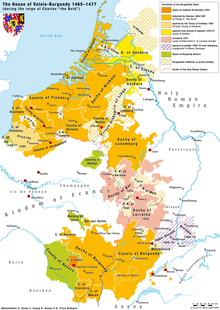Burgundian inheritance in the Low Countries: Difference between revisions
No edit summary |
|||
| Line 20: | Line 20: | ||
*In [[1478]], Mary married [[Maximilian I, Holy Roman Emperor|Maximilian I of Habsburg, Holy Roman Emperor]], beginning the period of the [[Habsburg Netherlands]]. |
*In [[1478]], Mary married [[Maximilian I, Holy Roman Emperor|Maximilian I of Habsburg, Holy Roman Emperor]], beginning the period of the [[Habsburg Netherlands]]. |
||
*In [[1506]], the grandson of Maximilian and Mary, [[Charles V, Holy Roman Emperor|Emperor Charles V]] inherited his family's Dutch lands. He is also the [[Holy Roman Emperor]] and [[King of Spain]]. |
*In [[1506]], the grandson of Maximilian and Mary, [[Charles V, Holy Roman Emperor|Emperor Charles V]] inherited his family's Dutch lands. He is also the [[Holy Roman Emperor]] and [[King of Spain]]. |
||
*In [[1524]], |
*In [[1524]], Charles conquered [[Friesland]], whih was renamed [[Lordship of Frisia]], during the [[Guelderian Wars]]. |
||
*In [[1528]], Charles liberated the [[Bishopric of Utrecht]] and its lands in [[Overijssel]], and annexed them as [[Lordship of Utrecht]] and [[Lordship of Overijssel]], during the [[Guelderian Wars]]. |
|||
*In [[1543]], Charles reclaimed and conquered Guelders. |
|||
*In [[1536]] Charles conquered the [[Lordship of Groningen]] and [[County of Drenthe]], during the [[Guelderian Wars]]. |
|||
*In [[1543]], Charles reclaimed and conquered the [[Duchy of Guelders]] and the [[County of Zutphen]] (in personal union), during the [[Guelderian Wars]]. |
|||
*In [[1549]], Charles V issued [[Pragmatic Sanction of 1549|a Pragmatic sanction]]; creating the [[Seventeen Provinces]]. |
*In [[1549]], Charles V issued [[Pragmatic Sanction of 1549|a Pragmatic sanction]]; creating the [[Seventeen Provinces]]. |
||
Revision as of 18:25, 8 February 2012

Around the 13th and early 14th century, various Dutch cities became so important that they started playing a major role in the political and economical affairs of their respective fiefs.[1] At the same time the political system of relatively petty lords was ending, and stronger rulers (with actual power over larger territories) started to emerge.
In the case of the Dutch, these two developments resulted in the political unification of all Dutch fiefs within a supra-regional state. This process started in the 14th century, with the Flemish cities gaining previously unseen powers over their county. When Louis II, Count of Flanders, died without a male heir, these cities (Bruges, Ypres and Ghent) arranged a marriage between his daughter and the Duke of Burgundy. By doing this, they set in motion a chain of events eventually leading to the Burgundian and, in 1478, the Habsburg Netherlands.
Under Burgundy
- In 1384, Philip the Bold acquired the county of Flanders, Artois, and the Franche-Comté by marrying Margaret III, Countess of Flanders, a marriage supported by the Flemish cities.
- In 1429, Philip the Good (the grandson of Philip the Bold) buys the County of Namur from John III, Marquis of Namur.
- In 1430, Philip of Brabant died childless, leaving his nephew Philip the Good as his heir in Brabant, Lothier, and Limburg.
- In 1432, the Hook and Cod wars ended in victory for the Hollandic cities, Philip the Good was offered to become count of Holland, Zeeland and Hainaut.
- In 1443, Philip conquers the Duchy of Luxembourg
- In 1456, Philip managed that his illegitimate son, David, was elected Bishop of Utrecht.
- In 1456, he also had his nephew Louis of Bourbon become Prince-Bishop of Liège, leading to the Liège Wars.
- In 1473, Philip's son, Charles the Bold buys the Duchy of Guelders from Duke Arnold. However the house of Burgundy lost this title at Charles's death in 1477.
- In 1477, Charles the Bold died fighting an alliance led by the King of France. France annexed the Duchy of Burgundy, but the title Duke of Burgundy remained in titular use, as seen with his only child, his daughter Mary of Burgundy.
Under Habsburg
- In 1478, Mary married Maximilian I of Habsburg, Holy Roman Emperor, beginning the period of the Habsburg Netherlands.
- In 1506, the grandson of Maximilian and Mary, Emperor Charles V inherited his family's Dutch lands. He is also the Holy Roman Emperor and King of Spain.
- In 1524, Charles conquered Friesland, whih was renamed Lordship of Frisia, during the Guelderian Wars.
- In 1528, Charles liberated the Bishopric of Utrecht and its lands in Overijssel, and annexed them as Lordship of Utrecht and Lordship of Overijssel, during the Guelderian Wars.
- In 1536 Charles conquered the Lordship of Groningen and County of Drenthe, during the Guelderian Wars.
- In 1543, Charles reclaimed and conquered the Duchy of Guelders and the County of Zutphen (in personal union), during the Guelderian Wars.
- In 1549, Charles V issued a Pragmatic sanction; creating the Seventeen Provinces.
Politically the Burgundian and Habsburg periods were of tremendous importance to the Dutch, as the various Dutch fiefs were now united politically into one single entity.[2] The period ended in great turmoil; as the rise of Protestantism, the centralist policies of the Habsburg Empire, and other factors resulted in the Dutch Revolt and the Eighty Years' War.
See also
References
- ^ "Low Countries, 1000–1400 A.D.", in Heilbrunn Timeline of Art History. New York: The Metropolitan Museum of Art, 2000
- ^ Chapter 3, Forming Political Unity, paragraph 3; The Age of Habsburg (1477–1588).
